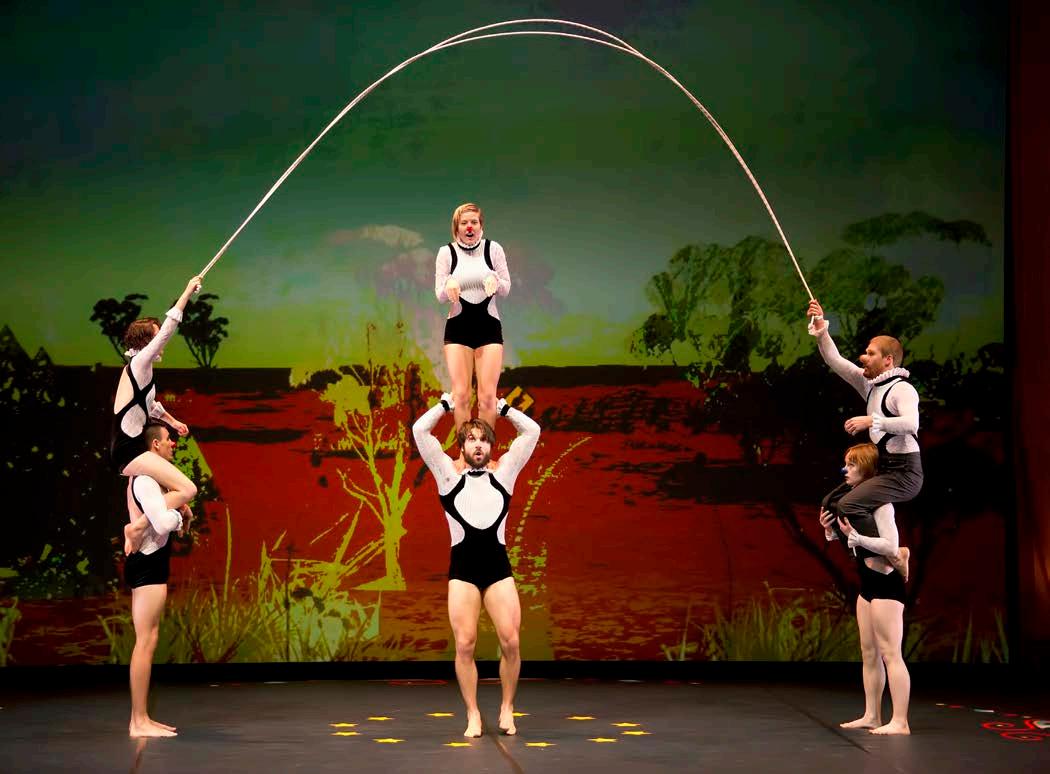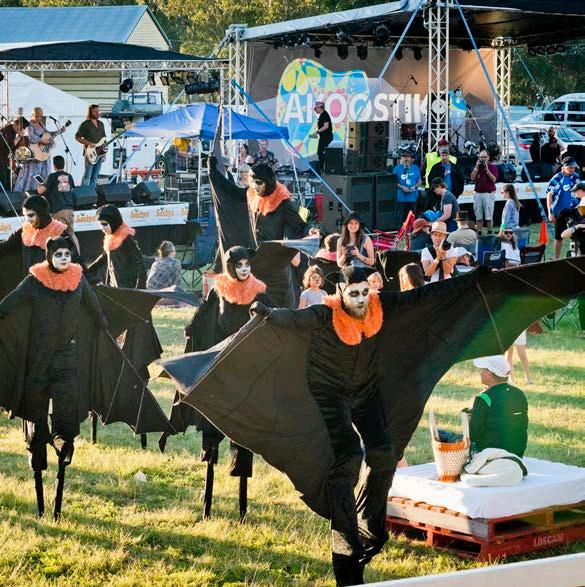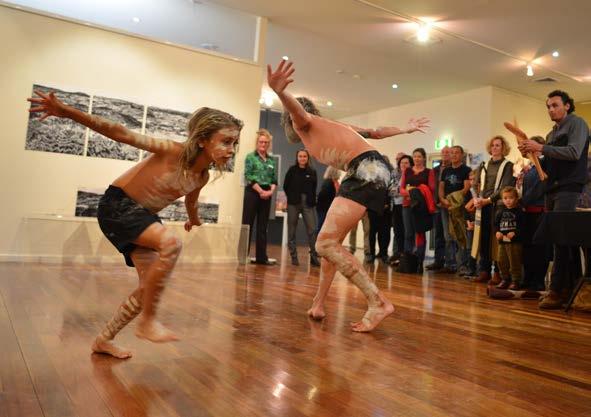
11 minute read
Enhancing our Infrastructure and Spaces
The role that Cultural Infrastructure must play in the community is evolving more rapidly than ever; as spaces that were once designated for artistic pursuits or cultural gatherings are now at the forefront of delivering programs that respond to the community’s financial, social and health needs.
The MidCoast region is increasingly in need of welcoming, easily accessible, adaptable spaces that not only cater to artistic expression, but also respond to the growing health risks of social isolation in its ageing populations, increased frequency of mental illness in young people and the need to build a more resilient local economy.
What is considered cultural infrastructure?
Create NSW (Cultural Infrastructure Plan 2025+) defines cultural infrastructure as “buildings and spaces that accommodate or support culture” and includes both private and public spaces where the expression of customs, traditions, heritage and social character2 .
Ganya marranggang#
The multi purpose use and availability of community spaces for creative sustainable initiatives. These could include short and long term availability of studios, workshops and a central location for conversations and events of sustainable interest.“
ONLINE SURVEY PARTICIPANT
2. Create NSW, NSW Cultural Infrastructure Plan 2025+ # Expressed in Gathang language. Refer to Appendix 1 for translation
Community and participatory spaces Commercial and enterprise spaces Practice, education and development spaces Performance and exhibition spaces Festival, event and public spaces
Cultural infrastructure for ‘active’ participation and spaces with resources and facilities for active making, doing and skill-sharing These include: Libraries Maker spaces Cultural centres Spaces for creative enterprise, including retail These include: Book stores Artist studios / shops Cultural infrastructure for professional creative practice and art form development These include: Theatres Dance school Rehearsal rooms Cultural venues and infrastructure for audiences or spectatorship These include: Music venues Museums Galleries Spaces for temporary, unplanned or ‘special event’ cultural use in the public domain These include: Parks Outdoor event spaces Public art installations
What we heard
The community recognise that the MidCoast region has a reasonable provision of basic public and community spaces, but desires to see these assets upgraded to be more adaptable in use, and more accessible and welcoming to a diverse range of users and programs. The co-locating of groups and organisations from different sectors was also suggested by participants - seen as an essential ingredient to building a more collaborative and economically resilient MidCoast.
Outcomes – what do we want?
19 Shared understanding of need but also cost associated with cultural infrastructure
20 Upgraded cultural infrastructure to better accommodate fit for purpose uses
21 Innovative ways we can adapt existing buildings to new, creative uses (or supporting uses)
22 Co-locating cultural producers to maximise investment but also spark innovation
23 Digital infrastructure that helps creatives connect, make and produce new work (ie smart region)

Community storytelling is most powerful when ideas are focused through the lens of the lived culture of a place. Local institutions are often trustees and repositories of local story and have enormous potential to establish and invigorate “ socio-cultural and economic creativity.
ONLINE SURVEY PARTICIPANT
Increasing amount of empty buildings – both beautiful and derelict - which I think have to be considered as potential for startups or people looking for a bricks and mortar option for their business. It has great potential for creatives, which is proven to reinvest in community vibrancy and commerce.“
SOCIAL PINPOINT PARTICIPANT
What is the strategy? Implementation Areas What does success look like?
4.1
Enhancing and adapting existing infrastructure for arts and culture
4.2
Strengthen our cultural and community hubs
4.3
Leveraging and expanding the libraries network 4.1.1 Identify and support the use of vacant and/ or underutilised Council buildings and private assets within town centers for creative and cultural purposes 4.1.2 Showcase existing businesses which co-locate with cultural uses
4.1.3 Align creative hubs and arts precincts with leisure, community, learning and local business to engage community and visitors 4.1.4 Ensure the Manning Regional Art Gallery and Manning Entertainment Centre are well maintained, sustainable and meet industry standards
4.2.1 Support and promote the important cultural experiences delivered by our museums and galleries 4.2.2 Strengthen the viability Regional Gallery in acquiring additional works for the collection, helping to build audience engagement, education and strengthen the ongoing viability of the collection 4.2.3 Establish policy and procedures for shared spaces in Community halls
4.3.1 Undertake investigations into establishing a road map and strategic plan for Taree and Wingham Libraries
4.3.2 Improve Library technology and bandwidth to help delivery programs 4.3.3 Investigate potential expansion of the Wingham Library and a plan for staffed branch at Old Bar Innovative ways we can adapt existing buildings to new, creative uses (or supporting uses) Upgraded and accessible cultural infrastructure to better accommodate fit for purpose uses Co-locating cultural producers to maximise investment but also spark innovation Shared understanding of need but also cost associated with cultural infrastructure
Digital infrastructure that helps creatives connect, make and produce new work (ie. smart region)
4.4
Make culture easily accessible to all 4.4.1 *Urgent* Audit cultural infrastructure and audit signage (including regulations, places and wayfinding) 4.4.2 Investigate potential sites and funding sources to deliver innovative ways to access arts and culture across the region 4.4.3 Create a supportive network with industry leaders mentoring emerging creatives 4.4.4 Amplify the voices of local creatives to recommend infrastructure which is suitable and bestplaced for success 4.4.5 Investigate opportunities to facilitate access to cultural exhibition and production spaces for younger demographics

What can you do?
A collection of quick and simple ideas for residents and businesses of MidCoast:
• Attend a show • Help promote cultural activity • Join your local library • Volunteer at a local space • Donate or offer works in-kind support • Have a say when it comes to planning and growth matters • Talk to your local Councillor • Join a local club or group • Join a Chamber of Commerce • Participate in local events

Images, from top: Carnival of the Animals, Photo by Justin Nicolas, Atmosphere Photography, MEC. Circartus, A Touch of The Brush Wingham Akoostik Music Festival. Wingham Winter Solstice Lantern Walk image by Julie Slavin.

Council wants to support the continued cultural development of organisations, events and activities that contribute to ensuring that our community is diverse, resilient and connected.
We want the community to take the MidCoast Cultural Plan 2036 as a benchmark and opportunity for more creative and cultural development. The more people that get behind the MidCoast Cultural Plan 2036 the more strength the strategies and implementation areas will have. We encourage you to take part as much as you want and can. Talk about the MidCoast Cultural Plan 2036 with locals, get together and tell us how you want to make it happen.
Here are some easy ways you could get involved with the MidCoast Cultural Plan 2036:
Join your community cultural or creative organisation Join a history group
Acknowledge traditional place names and Gathang language in everyday life
Showcase your talent through the Vibrant Spaces program
Start a Neighbourhood Noticeboard Continue the conversation and keep thinking bold
Comment on this Cultural Plan Attend an event at the Manning Regional Art Gallery or the Manning Entertainment Centre
Document and talk to us about your great ideas for local events
Join an amateur singing or actors group Volunteer with an existing community arts organisation
Join a book group Buy or commission an artwork from your local artist or pop-up gallery Start planning a community mural using our Public Art Guidelines
Join your local Library
Join a writers group

Gathang is the language of the people known as the Birrbay, Warrimay and Guringay.
Years ago, Gathang speakers would have been multilingual, also speaking the languages of their neighbours. There are significant social relationships amongst Birrbay, Anaiwan (Nganyawana), Dhanggati and Gumbaynggirr peoples, including a shared set of marriage sections. The Guringay marriage sections are shared with the Wanarruwa, who spoke the language from the Hunter River and Lake Macquarie (HRLM), Darkinyung and Gamilaraay peoples. The journey of the Gathang language is an exciting one with so many cultural knowledge holders leading the way for the future. To find out more the Muurrbay Aboriginal Language and Culture Co-operative is a great place to start https://muurrbay.org.au To connect with the Gathang Langauge Group about the protocols and processes around the language and uses please contact: Muurrbay Aboriginal Language and Culture Co-op 14 Bellwood Road NAMBUCCA HEADS NSW 2448 Telephone: 02 6569 4294
https://www.firstvoices.com/explore/FV/sections/Data/Pama-nyugan/Gathang/Gathang Gathang phrases with approximate English translation
Gathang language English translation
Barrayga Djiranggaan Pride in Country
Nyiirun maray guunggu bathu maayngi We will go to the river to get water
Wanyimbu Wanyimbu Ganyila, Wanyimbu Wanyimbu Ganyiy Always was always will be
Birrbay, Warrimay, Guringay barray Biripi, Worrimi and Guringay Country
Wakulda wuwang
Ganya marranggang Number one work
Beautiful house

Image: Worimi Dancers, MRAG image by Julie Slavin
APPENDIX 2 - GLOSSARY
Culture
Cultural Planning
The production, distribution and participation in creativity by residents, workers and visitors, and the reflection and expression of a place’s customs, traditions, heritage and social character. Includes visual and performing arts, music, museums and galleries, the representation and animation of our history and heritage, libraries, craft, design, food, publishing, film, literature, digital and new media, television, interactive software, creativity in the public realm such as the design of public spaces, imaginative use of lighting and expressions of community identity through events and place-based celebrations. Source: adapted from Cultural Infrastructure Plan 2025+, Create NSW
Aims to assist in the realisation of a desired future, to provide a platform for the community’s values and aspirations, and fuel social and economic development. Arts and culture has been found to play a significant role in the community with its contribution to community vibrancy, social cohesion, community capacity building and cultural identity and expression. When a strategic approach is taken in this area, the outcomes can be of even greater significance.
The Arts The material ways we communicate cultural ideas and beliefs.
Cultural Development
Using arts and culture activities to engage the community and realise a desired future. It describes collaborations in a number of forms which can result in social and economic development outcomes.
Cultural Infrastructure
Aboriginal Cultural Heritage Values:
Aboriginal Place:
Private and public buildings and spaces that accommodate or support the expression of customs, traditions, heritage and social character (Source: adapted from Cultural Infrastructure Plan 2025+, Create NSW). Sometimes broken down as (Source: adapted from The City of Sydney): • Spaces for ‘active’ public participation • Facilities supporting professional creative practice and artform development • Spaces for creative enterprise including retail • Cultural ‘venues’ for audiences or spectatorship / ‘passive’ public participation • Spaces for temporary, unplanned or ‘special event’ cultural use in the public domain
Traditional values of Aboriginal people, handed down in spiritual beliefs, stories and community practices and may include local plant and animal species, places that are important and ways of showing respect for other people.
Locations recognised by the Minister for Climate Change and the Environment (and gazetted under the National Parks and Wildlife Act 1974) as having special cultural significance to the Aboriginal community. May or may not include archaeological materials.
Aboriginal Site:
Placemaking
Creative Placemaking
Resilience
Public Art
Community initiated Art
Public Domain / Public Realm
The location of one or more Aboriginal archaeological objects, such as flaked stone artefacts, midden shell, grinding grooves, archaeological deposits, or scarred trees.
A collaborative approach drawing on the knowledge of the local community to deliver active, fun, inclusive and well-designed shared spaces to support happier and healthier communities. It acknowledges the interconnected nature of physical, cultural, ecological, economic and spiritual qualities of a place (Project for Public Spaces).
The use of arts and culture by diverse partners to strategically shape the physical and social character of a place in order to spur economic development, promote enduring social change and improve the physical environment.
The capacity of individuals, communities, institutions, businesses, and systems to survive, adapt, and grow no matter what kinds of chronic stresses and acute shocks they experience (Source: www.100resilientcities.org/cities/entry/sydney). • Chronic stresses are ongoing or cyclical stresses that weaken the fabric and resilience of a community on a daily basis, eg. lack of housing affordability or employment opportunities. • Acute shocks are the sudden, sharp events that threaten communities, such as extreme weather events like bushfires and flooding, infrastructure failure, water crises, or disease pandemics.
A broad range of works of art approved or procured by Council located in a public space or in private spaces accessible to the public. May be permanent, temporary or ephemeral nature, and can include music, sound and light installations, sculptures, wall murals or street furniture.
Art that is conceptualised, led, and created by the community with Council approval.
Spaces that are visible, accessible, and used by the public, including public and private spaces.
Public Space Spaces under the care, control and management of Council.
Street Art Art created in streets designated by Council to revitalise spaces eg. laneways.

With thanks to…
Mayor, Councillors, General Manager and Council staff for their contributions and assistance, and for being cultural champions. MidCoast Cultural Plan 2036 Reference group Gathang Language Group Community members who provided feedback All volunteers and their families who work tirelessly to bring the MidCoast to life








